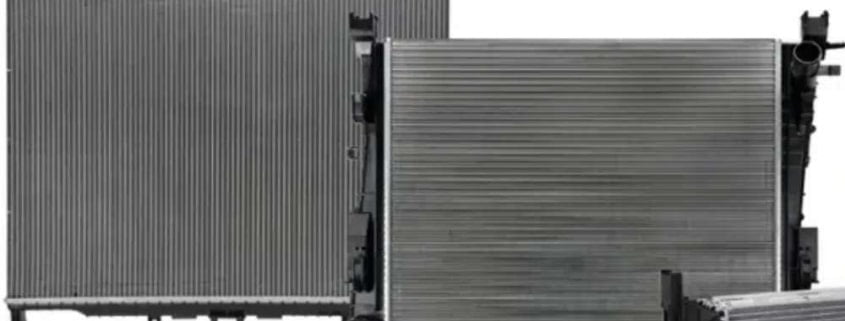Plastic radiator repair: Can you fix a cracked radiator tank?
A plastic radiator tank can sometimes be repaired using epoxy, fibreglass, or plastic welding, but large cracks or brittle tanks usually require full replacement to prevent leaks and overheating.
This guide explains how plastic car radiators work, why they crack, common repair methods, how long they last, and when to replace the radiator instead of repairing it.
Can a plastic radiator be repaired?
A cracked plastic radiator can sometimes be repaired if the damage is small and in an accessible area. Temporary fixes may include a two-part epoxy, fibreglass patch, or plastic welding kit. These repairs can seal a hairline crack or pinhole leak long enough to get the vehicle running safely.
However, plastic radiator tanks are made from nylon composites that expand and contract under heat cycles. This means that most repairs are not permanent, and the crack can reopen over time. If the plastic tank radiator is badly cracked, leaking near a hose connection, or showing multiple failures, a replacement radiator is usually the only reliable option.
Natrad technicians provide car radiator repairs and can advise whether a plastic tank can be sealed or if a new radiator is the safer choice.
What causes cracks in plastic radiators?
Plastic radiator cracks usually form in the end tanks, hose outlets, or seams where heat and pressure are concentrated. Over time, the plastic expands and contracts as the coolant heats and cools, leading to fatigue and eventual failure.
Common causes of cracks include:
- Repeated heat cycles make the plastic brittle
- Excess coolant pressure from a faulty thermostat or radiator cap
- Stress at hose connections
- Age-related deterioration of the plastic material
Cracks that form suddenly while the car is overheating are especially dangerous. According to NSW Government safety alerts, opening a radiator cap while hot can cause coolant to erupt and lead to severe burns. Always let the engine cool before checking for leaks.
How to fix a leaking plastic car radiator?
Small leaks in a plastic radiator can sometimes be fixed using consumer repair products. The most common emergency repair methods include:
- Two-part epoxy – mixed and applied directly to the cracked area after sanding and cleaning.
- Fibreglass patch – layered over the epoxy to reinforce the repair.
- Plastic welding – uses heat to fuse the nylon plastic along the crack.
While these methods may temporarily seal the leak, they are not guaranteed to withstand the heat and pressure of daily driving for a long time. A professional inspection is recommended to confirm whether the radiator is still safe.
Epoxy vs fibreglass vs plastic weld vs replacement
| Method | Best for | Durability | Pros | Cons | When to choose |
|---|---|---|---|---|---|
| Two-part epoxy | Small hairline cracks away from hose necks | Temporary (weeks–months) | Cheap, easy to apply, widely available | Weak under high heat/pressure, may re-crack quickly | Use only as a temporary fix to get back on the road |
| Fiberglass patch | Reinforcing epoxy repairs | Temporary–medium | Stronger than epoxy alone, adds rigidity | Time-consuming, still prone to fatigue | Use if epoxy alone isn’t enough, but radiator isn’t yet due for replacement |
| Plastic weld | Cracks in nylon tanks (PA66-GF) | Medium–long term | Bonds with tank material, more durable | Requires tools/skill, not always accessible areas | Choose if crack is small, clean, and tank is otherwise in good condition |
| Replacement radiator | Large cracks, brittle tanks, aged units | Permanent (8–10 years) | Restores full strength, includes warranty | Higher upfront cost | Best choice for long-term reliability, safety, and preventing engine damage |
How long do plastic radiators last?
Plastic car radiators generally last around 8–10 years before fatigue or cracks appear in the end tanks. Their lifespan depends on several factors, including the quality of coolant, whether the cooling system is regularly serviced, and how much heat stress the engine produces.
Older plastic radiators often show hairline cracks near the top tank or hose outlets. If left unchecked, these can expand and cause coolant loss, leading to overheating and engine damage.
If your radiator is close to a decade old or showing signs of wear, consider a replacement radiator from Natrad for long-term reliability.
What type of plastic is used in radiator tanks?
Most modern radiator tanks are made from glass-reinforced nylon. This material is lightweight, heat-resistant, and strong enough to hold coolant under pressure. However, even reinforced plastics deteriorate over time from repeated heat cycles, vibration, and chemical exposure.
Radiator repairers are trained to inspect and replace plastic tanks when they are no longer structurally sound.
When should you replace a plastic radiator instead of repairing it?
Small, clean cracks in the middle of a plastic tank may sometimes be repaired. However, replacement is the better option when:
- The crack is longer than 50 mm or is branching in multiple directions
- The plastic is brittle or shows multiple hairline fractures
- The leak is near a hose neck, seam, or mounting point
- The radiator is more than 8–10 years old
Driving with a cracked radiator can lead to overheating and serious engine damage. In these cases, a new radiator is safer and more cost-effective than repeated repairs.
Natrad offers plastic/aluminium radiator replacements across Australia, backed by a 3-year nationwide warranty.
Having trouble with a cracked plastic radiator tank? Don’t risk an overheating engine. Book a radiator inspection and get expert advice on repair or replacement. We have over 50 workshops, so we can serve you whether you’re in Melbourne or Adelaide.

FAQs about plastic radiator repair and replacement
Can I weld a plastic radiator?
Yes, plastic welding kits can repair some nylon radiator tanks. However, success depends on the crack’s size and location. Small, clean cracks may be sealed effectively, but larger or multiple cracks usually require full radiator replacement for safety and reliability.
What epoxy works on a plastic radiator tank?
Two-part radiator epoxies are commonly sold in Australia and may temporarily seal a crack. Reinforcing with fibreglass helps improve strength.
Why do plastic radiators crack?
Heat cycles, coolant pressure, and age-related deterioration cause stress fractures in plastic tanks.
How long does a plastic radiator repair last?
Temporary repairs may last weeks or months, but are not permanent solutions. Replacement is recommended for long-term reliability.
Is it cheaper to repair or replace a plastic radiator?
While a small DIY repair is cheaper in the short term, replacement provides lasting performance, a warranty, and peace of mind.
Book a radiator check with Natrad
If your radiator is showing cracks or leaks, now’s the time to act. Nip into Natrad for a radiator check-up and get reliable advice on whether to repair or replace. With branches in Melbourne, Brisbane, Perth and beyond, our team is ready to help keep your car running cool.








